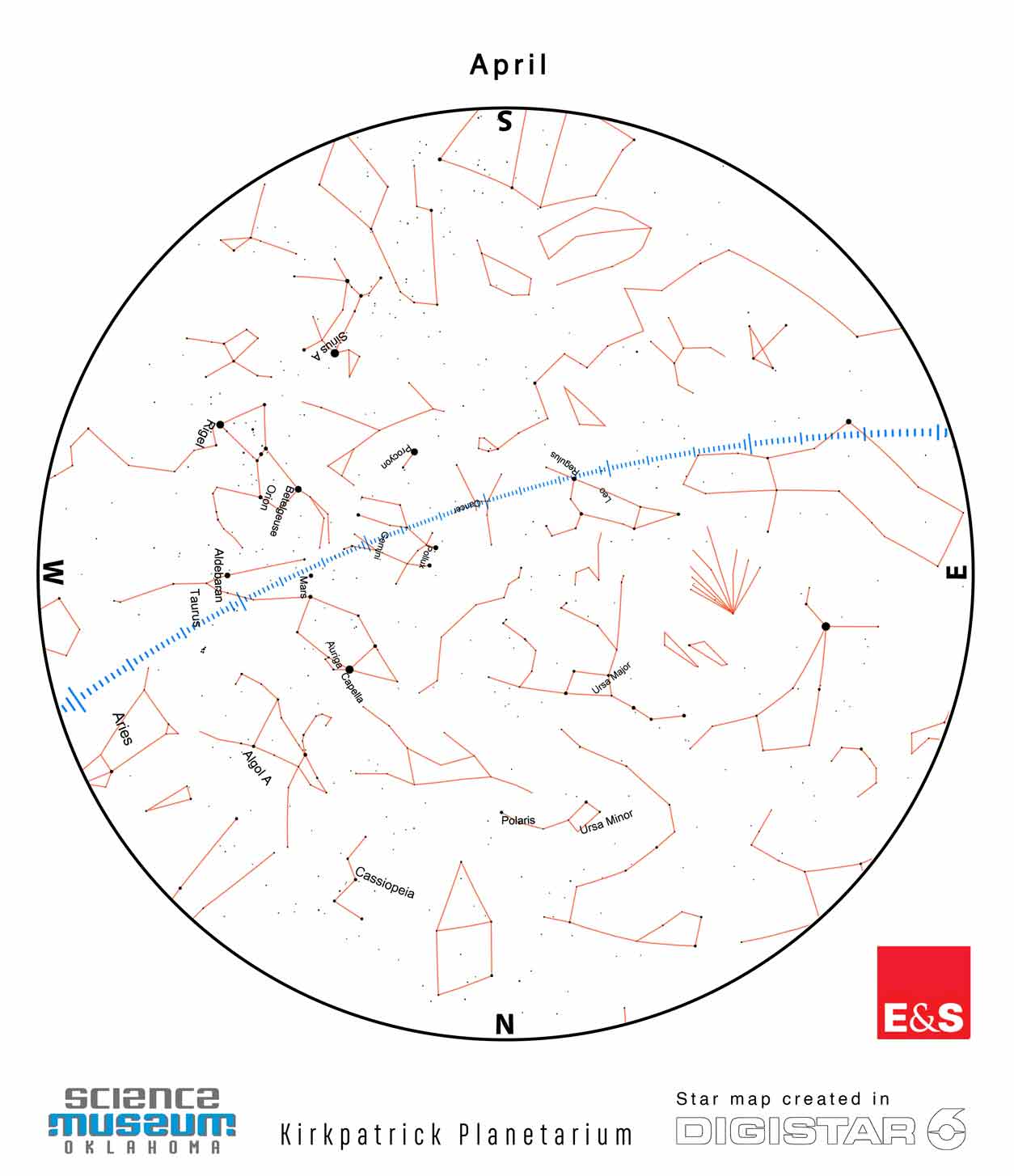Red Dirt Astronomy: Skies & Space for April 2022
March 31, 2022
Star Chart for April 2022
Planets
Mercury – Lost is the glow of the sun as the month begins, the planet will emerge in the evening sky by mid-month and climbing higher as the days pass. On April 29, Mercury will reach its highest altitude in the sky, shining brightly as the lone planet this month for evening observers.
Venus- Like Mars, Jupiter, Saturn, Uranus, and Neptune, Venus is in the morning sky, leaving the evening sky to Mercury. Gradually moving away from Mars and Saturn throughout April, the planet will overtake Uranus and Neptune on April 27. Although very close to Neptune that night, the extreme brightness of Venus outshines Neptune by 12 magnitude -- over a 100 times dimmer!
Mars – The planet will be close to Saturn on April 4, with both planets sharing close to the same brightness in the blue morning twilight. On April 25, the waning crescent moon will pass close to Mars.
Jupiter – On April 12, Jupiter will pass very close to Neptune, yet out shining it by 10 magnitudes. By mid-month, Jupiter will pass from Aquarius into Pisces, appearing on the eastern end of the line of planets: Venus, Mars, and Saturn. On April 30, Jupiter and Venus will form a very bright pair in the morning sky.
Saturn- Saturn begins the month close to Mars and Venus, the trio forming a conjunction April 4-5 . By mid-month, Saturn will be the western most of the planet line in the morning sky. On April 24-25, the waning crescent moon will pass close by.
Uranus- Uranus will be fading into the morning twilight as the month begins and soon lost in the rising sun’s glow.
Neptune- Neptune will gradually emerge from the morning twilight in Aquarius in the first part of the month. On April 12, it will form a conjunction with Jupiter and then Venus on April 27 See the magnitude details above under Saturn and Jupiter.
Sky & Space Anniversary Events for April 2022
- April 1: new moon
- April 3: Uranus 0.6 degree north of moon
- April 4: Mars 0.3 degree south of Saturn
- April 9: first quarter moon
- April 12: Yuri Gagarin aboard Vostok 1 becomes first human in space
- April 12: First flight of the Space Shuttle
- April 12: Jake Garn becomes first politician in space
- April 12: Jupiter 0.1 degree north of Neptune
- April 14: Apollo 13 explosion of the fuel cell in the Service Module – mission abort
- April 16: Apollo 16 launched to the moon
- April 16: full moon
- April 17: Surveyor 3 launched to the moon
- April 18: Mercury 2 degrees north of Uranus
- April 22: Lyrid Meterors (see data below)
- April 23: last quarter moon
- April 27: Venus 4 degrees north of moon
- April 27: Jupiter 4 degrees north of Moon
- April 27: Venus 0.1 degree south of Neptune
- April 29: Mercury at highest altitude in the sky
- April 30: new moon
- April 30: Venus 0.2 degrees south of Jupiter
LYRID Meteors
With only 10-15 meteors per hour predicted under a dark sky, the Lyrids are known for uncommon surges, producing over 100 per hour. Named for the constellation of Lyra, many of these meteors leave an ionization trail as they burn up high in the Earth’s atmosphere, sometimes hanging in the sky for several seconds after the meteor has faded. This month, the crescent moon will be in the sky, making observation a challenge. However, observing time for the Lyrids is April 21-22. Try observing the shower on the evening of April 22. This will provide a slightly darker sky as the moon crescent decreases. Yet even this will make seeing a Lyrid difficult.
The radiant -- the point of origin of the shower -- will rise before midnight and be well placed before dawn, located near the bright star Vega in Lyra the harp. Always look for the Lyrids closer to the eastern horizon.


